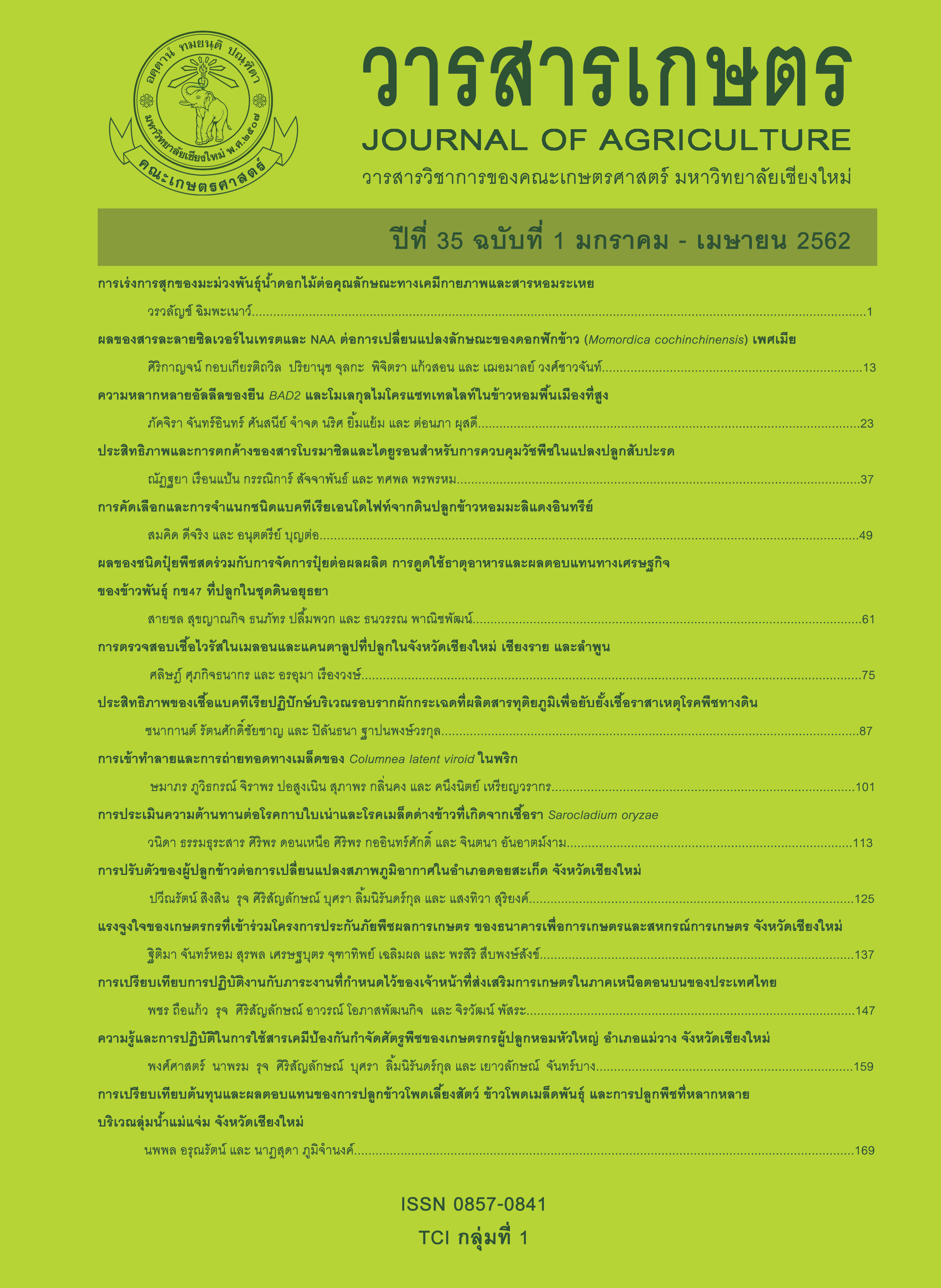การตรวจสอบเชื้อไวรัสในเมลอนและแคนตาลูปที่ปลูกในจังหวัดเชียงใหม่ เชียงราย และลำพูน
Main Article Content
บทคัดย่อ
เก็บตัวอย่างใบเมลอนและแคนตาลูปที่แสดงอาการของโรคไวรัส จากพื้นที่ปลูกในจังหวัดเชียงใหม่ เชียงราย และลำพูน ทั้งในสภาพโรงเรือนและแปลงเปิด ตรวจสอบเชื้อไวรัสโดยใช้เทคนิค enzyme-linked immunosorbent assay (ELISA) ร่วมกับโมโนโคลนอลแอนติบอดีและโพลีโคลนอลแอนติบอดี ซึ่งจากการตรวจตัวอย่างใบพืชทั้งหมด 163 ตัวอย่างด้วยวิธี ELISA พบว่า Melon yellow spot virus (MYSV) เป็นเชื้อไวรัสที่ตรวจพบได้มากที่สุดคิดเป็นร้อยละ 68.7 รองลงมาคือสกุล Geminivirus (ร้อยละ 4.9), Papaya ringspot virus (PRSV) (ร้อยละ 2.4) และ Zucchini yellow mosaic virus (ZYMV) (ร้อยละ 2.4) ในขณะที่ตรวจพบสกุล Begomovirus และ Watermelon silver mottle virus (WSMoV) เป็นจำนวนร้อยละ 1.8 และ 1.2 ตามลำดับ นอกจากนี้ จากการสำรวจ พบการเข้าทำลายร่วมกัน ของเชื้อไวรัสมากกว่า 1 ชนิด ได้แก่ MYSV ที่เข้าทำลายร่วมกับสกุล Geminivirus ซึ่งพบได้มากที่สุด รองลงมาคือสกุล Begomovirus ที่เข้าทำลายร่วมกับสกุล Geminivirus และพบการเข้าทำลายร่วมกันของ PRSV กับ ZYMV นอกจากนี้ พบการเข้าทำลายร่วมกันของเชื้อไวรัส 3 ชนิด ได้แก่ PRSV, WSMoV และ ZYMV เมื่อตรวจสอบลักษณะอนุภาคของเชื้อไวรัสภายใต้กล้องจุลทรรศน์อิเล็กตรอนแบบส่องผ่าน พบว่า MYSV มีรูปร่างค่อนข้างกลมและมีเยื่อหุ้มอนุภาค มีขนาดเฉลี่ยเท่ากับ 80-150 นาโนเมตร พบอนุภาคไวรัสลักษณะเป็นเส้นยาวคดของ PRSV มีขนาดเฉลี่ยเท่ากับ 650-85 นาโนเมตร และอนุภาคไวรัสที่อยู่เป็นทรงกลมคู่ของสกุล Geminivirus มีขนาดเฉลี่ยเท่ากับ 22 x 38 นาโนเมตร จากผลการตรวจสอบตัวอย่างใบเมลอนและแคนตาลูปที่แสดงอาการโรคไวรัสใน 3 จังหวัด สามารถสรุปได้ว่า MYSV เป็นเชื้อไวรัสที่สร้างความเสียหายมากที่สุต่อการปลูกเมลอนและแคนตาลูป ทั้งในสภาพโรงเรือนและแปลงเปิด
Article Details
เอกสารอ้างอิง
กัลยาณี ชัยชนะ ประสาทพร สมิตะมาน และ มณีฉัตร นิกรพันธุ์. 2552. การปรับปรุงพันธุ์ต้านทานโรคไวรัสใบหงิกเหลืองของมะเขือเทศ. วารสารเกษตร 25(3): 219-227.
จันทรา อุปาลี และ อรอุมา เรืองวงษ์. 2561. การคัดเลือกไรโซแบคทีเรียที่เป็ นปฏิปักษ์ต่อเชื้อสาเหตุโรคต้นแตกยางไหลของเมลอน. วารสารเกษตร 34(2): 179-191.
ณัฐธิกา วรรณรัตน์ และ เกวลิน คุณาศักดากุล. 2559. การผลิตหอมแดงปลอดเชื้อไวรัสด้วยเทคนิคการเพาะเลี้ยงเนื้อเยื่อ. วารสารเกษตร 32(3): 347-356.
ยุทธ ทนโม๊ะ และ เพชรรัตน์ ธรรมเบญจพล. 2551. โรคไวรัสในแปลงผลิตเมล็ดพันธุ์พืชวงศ์แตงภาคตะวันออกเฉียงเหนือของประเทศไทย. หน้า 12-18. ใน: รายงานสัมมนาวิทยาศาสตร์เกษตร มหาวิทยาลัยขอนแก่น ครั้งที่ 28, ขอนแก่น.
สุดารัตน์ แก้วน้ำอ่าง อังสนา อัครพิศาล และ อรอุมา เรืองวงษ์. 2561. การคัดเลือกไรโซแบคทีเรียในการควบคุมโรคผลเน่าที่เกิดจากแบคทีเรียของ เมลอน. วารสารเกษตร 34(2): 193-204.
อภิชาต ศรีสะอาด และ สุธิพงศ์ ถิ่นเขาน้อย. 2558. เมลอน & แคนตาลูป เงินล้าน. นาคาอินเตอร์-มีเดีย, กรุงเทพฯ. 136 หน้า.
Ali, A., A. Hussain and M. Ahmad. 2014. Occurrence and molecular characterization of Cucumber green mottle mosaic virus in cucurbit crops of KPK, Pakistan. Brazilian Journal of Microbiology 45(4): 1247-1253.
Ali, A., O. Mohammad and A. Khattab. 2012. Distribution of viruses infecting cucurbit crops and isolation of potential new virus-like sequences from weeds in Oklahoma. Plant Disease 96(2): 243-248.
Dombrovsky, A., H. Huet, N. Chejanovsky and B. Raccah. 2005. Aphid transmission of a Potyvirus depends on suitability of the helper component and the N terminus of the coat protein. Archives of Virology 150(2): 287-298.
Fattouh, F.A. 2003. Double infection of a cucurbit host by Zucchini yellow mosaic virus and Cucumber mosaic virus. Pakistan Journal of Plant Pathology 2: 85-90.
Gajanandana, O., C. Seepiban, S. Pansa-ard, A. Bhunchoth, A. Warin, O. Himananto, P. Pongsapic, P. Chiemsombat and R. Hongprayoon. 2006. Production of antibodies for detection of tospoviruses in Thailand. pp. 556-563. In: Proceedings of the 44th Kasetsart University Annual Conference. Kasetsart University, Bangkok.
Gil-Salas, F.M., J. Peters, N. Boonham, I.M. Cuadrado and D. Janssen. 2012. Co-infection with Cucumber vein yellowing virus and Cucurbit yellow stunting disorder virus leading to synergism in cucumber. Plant Pathology 61: 468-478.
Kato, K., K. Handa and M. Kameya-Iwaki. 2000. Melon yellow spot virus: a distinct species of the genus Tospovirus isolated from melon. Phytopathology 90(4): 422-426.
Kumar, S., A. Sankarlingam and R. Rabindran. 2014. Characterization and confirmation of Papaya ringspot virus-W strain infecting Trichosanthes cucumerina at Tamil Nadu, India. Journal of Plant Pathology and Microbiology 5: 225, doi: 10.4172/2157-7471.1000225.
Lecoq, H., C. Desbiez, C. Wipf-Scheibel and M. Girard. 2003. Potential involvement of melon fruit in the long distance dissemination of cucurbit Potyviruses. Plant Disease 87(8): 955-959.
Mansilla, P.J., A.G. Moreira, A.P.O.A. Mello, J.A. M. Rezende, J. A. Ventura, V. A. Yuki and F. J. Levatti. 2013. Importance of cucurbits in the epidemiology of Papaya ringspot virus type P. Plant Pathology 62(3): 571-577.
Mowat, W.P. and S. Dawson. 1987. Detection and identification of plant viruses by ELISA using crude sap extracts and unfractionated antisera. Journal of Virological Methods 15(3): 233-247.
Peng, J.C., S.D. Yeh, L.H. Huang, J.T. Li, Y.F. Cheng and T.C. Chen. 2011. Emerging threat of thrips-borne Melon yellow spot virus on melon and watermelon in Taiwan. European Journal of Plant Pathology 130: 205-214.
Romay, G., H. Lecoq, F. Geraud-Pouey, D.T. Chirinos and C. Desbiez. 2014. Current status of cucurbit viruses in Venezuela and characterization of Venezuelan isolates of Zucchini yellow mosaic virus. Plant Pathology 63(1): 78-87.
Syller, J. 2012. Facilitative and antagonistic interactions between plant viruses in mixed infections. Molecular Plant Pathology 13(2): 204-216.
Trkulja, V., D. Kovacic, B. Curkovic, A. Vucurovic, I. Stankovic, A. Bulajic and B. Krstic. 2013. First report of Cucumber mosaic virus on melon in Bosnia and Herzegovina. Plant Disease 97(8): 1124.
Whitfield, A.E., B.W. Falk and D. Rotenberg. 2015. Insect vector-mediated transmission of plant viruses. Virology 479-480: 278-289.
Zechmann, B. and G. Zellnig. 2009. Rapid diagnosis of plant virus diseases by transmission electron microscopy. Journal of Virological Methods 162(1-2): 163-169.
Zerbini, F.M., R.W. Briddon, A. Idris, D.P. Martin, E. Moriones, J. Navas-Castillo, R. Rivera-Bustamante, P. Roumagnac and A. Varsani. 2017. ICTV Virus Taxonomy Profile: Geminiviridae. The Journal of General Virology 98(2): 131-133.


